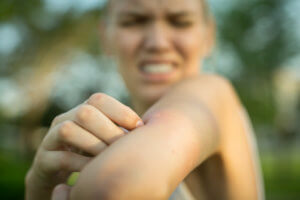Mosquito Bites vs. Tick Bites
As the weather warms up, those bothersome backyard pests reintroduce themselves to you and your outdoor activities. It can be a real buzzkill having mosquitoes or ticks around on a long walk or during an afternoon firing up the grill. Not only are these pests a nuisance, but they can also leave itchy bites and even transmit infectious diseases.

Ticks and mosquitoes both leave small red bumps behind after they bite, so being able to tell the difference between the two can be challenging if you didn’t catch a glimpse of the bug itself.
Mosquito Bites
Mosquitoes are some of the most prevalent and visible outdoor pests. Typically, where there is one mosquito, there are hundreds more nearby. Mosquitoes tend to breed in stagnant water like marshes, but did you know they also love taking advantage of everyday backyard items like pools, bird baths, flowerpots, and baby pools? Simple ways to avoid mosquito bites are to dump water out of backyard items and cover your pool.
When a mosquito bites, it injects saliva into your skin. This can leave itchy, irritating bumps on its victim and can sometimes lead to more severe reactions in those who are allergic. Mosquito bites are considered extremely dangerous in some cases because they can cause serious ailments like the West Nile virus, yellow fever, malaria, and Zika virus.
Mosquito bites will be hard bumps that are puffy with a red dot in the middle. These bites can resemble a blister more than a bump sometimes. On some occasions, they will grow as they heal.
Tick Bites
The other common and unwelcomed backyard guest is the tick, whose bite can often be confused with that of a mosquito. Ticks are small bugs with eight legs who embed themselves on animal or human hosts for days at a time to feed on blood. While they can start off as small as a pinhead, ticks grow over time as they take in more blood and can grow to the size of a marble.
While mosquito bites will feel itchy almost instantly, tick bites can go unnoticed in their early stages. Often someone who has been bitten by a tick may not realize it until after the fact. Tick bites are red around the bite area, and, in some instances, the tick itself will still be intact on the skin. They sometimes develop a red ring around them resembling a bullseye.
While tick bites are often harmless, they can cause allergic reactions including pain, swelling, a rash, a burning sensation, blisters, or difficulty breathing. In some cases, ticks pass on diseases to humans and pets such as Lyme disease or Rocky Mountain spotted fever. Symptoms of tick-borne diseases include weakness, chills, fever, redness near the bite, a rash, joint pain, and nausea.
It’s important to remove ticks carefully using tweezers to grasp the tick as close to your skin as possible. After removing the tick, remember to wash your hands and the bite site. If you can’t remove the tick, it’s imperative to make an appointment with your doctor.
Because mosquito bites and tick bites can closely resemble each other, knowing what differences to look for can help you identify which bite and which pest you’re dealing with – and ultimately, how to help prevent them in the future!